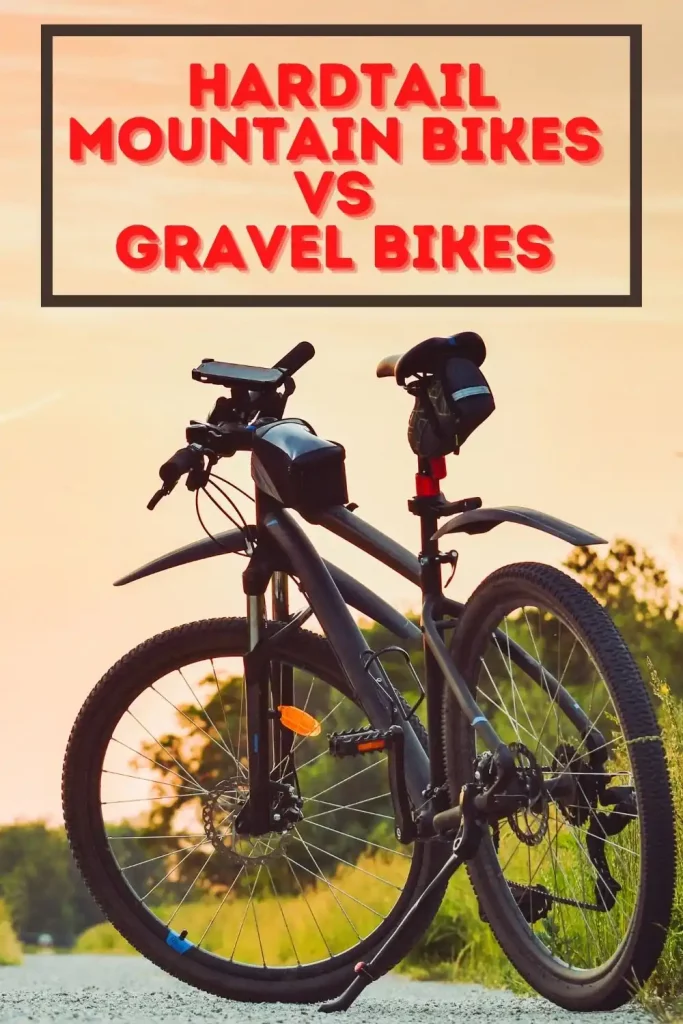Gravel bikes are a mixture of mountain bikes and road bikes. They have some features of road bikes and some features of mountain bikes. But do we need a gravel bike? Why gravel bikes ended but now raise a new trend! Are mountain bikes more preferable to gravel bikes?

So here are some factors on the basis we can differentiate gravel bikes vs mountain bikes:
Key Differences Between Hardtail Mountain Bikes Vs Gravel Bikes
Gravel Bikes
- Big tire size (27.5er – 29er)
- Less wide tire (38-45mm)
- Rigid or hardtail frame
- Drop handlebars
- Short reach
- 2x or 3x drivetrains
- Less cassette range ( 10 – 42t)
- More aerodynamic
- Better speed on roads and slightly rough terrains
Hardtail MountainBikes
- Smaller tire size (26 – 27.5er)
- Wider tires ( 53 – 60 mm)
- Hardtail or Full Suspension
- Flat handlebars
- Long reach
- 1x drivetrains
- More cassette range (10 – 50t)
- Less aerodynamic
- Better for climbing, steep descents, and rugged rocky terrains
1. Handlebars of Mountain Bikes Vs Gravel Bikes

Mountain bikes have a wider flat handlebar of 760-780mm (29-30 inches), which provides more stability on rough terrains and feels more secure in facing obstacles.
Gravel bikes have drop handlebars with short reach (distance from the seat to the handle), giving them an aerodynamic position and providing comfort for long rides.
2. Knobby Tires

Mountain bikes have wider tires (53-60mm) to control rough terrains and cross bumps and rocks efficiently. Moreover, they have more knobby (high tread) tires to provide better grip & traction on rough terrains. Tire sizes vary from 26 – 27.5er
Meanwhile, gravel bikes also have wider tires than road bikes, but these are not wider than mountain bike tires. Maximum gravel bikes have 50mm (1.97 inches) wide tires. But tire size varies from 27.5-29er for top speed on roads.
3. Suspension

Gravel bikes mostly have a rigid frame suitable for road pavements, and few gravel bikes are hardtails. Mountain bikes have at least a hardtail body, and most of the mountain bikes are full suspension. But you can adjust the shocks and forks of mountain bikes.
4. Gears and Crankshaft
Gravel have a wide range of gears, they usually have two or three chainrings (2x/3x drivetrains), and the hardest gear is 44t-10t (44 tooth front and 10 teeth rear side); the easiest gear is 42t-44t with SRAM XPLR cassettes.
Most mountain bikes have a single chainring (1x drivetrain), reducing their weight and having fewer moving parts.
But more range of bike sprockets in the cassette fills the gap; thus, the hardest gear is 32t-10t, and the easiest gear is 32t-52t with SRAM XX1 Eagle.
5. More Aerodynamics
Mountain bikes have low aerodynamic profiles due to wider handlebars, broad wheelbase, and long reach. There is no need for aerodynamics in mountain biking because these are designed for passing rocky tracks, mud, climbing, and descending, requiring more stability and handling control.
Gravel bikes have drop handles, a low wheelbase, a less tread tire, making them more aerodynamic.
Drop handlebars with short reach make riders bend down their upper body at 45 degrees and more, making them suitable for efficient long-riding on roads. Still, these bikes have significantly less stability on rugged terrains and descents.
6. Frame Geometry
Gravel has upright geometry with a tube head angle of 62-65 degrees like mountain bikes, providing better comfort and more stability on riding. Drop bars on gravel bikes give extra comfort on long rides.
So, in comparing mountain bikes vs gravel bikes in the aspect of frame geometry, they are both more likely the same, but usually, high-end mountain bikes have lightweight frames that help climb up hills.

How Do I Convert My Mountain Bike to Gravel?
Fortunately, most of the differences between mountain bikes and gravel bikes are convertible. Low tread lightweight tires will reduce resistance to road surfaces, which will significantly affect speed.
You can make your hardtail mountain bike more likely into gravel bikes by changing and adding some equipment.
These changes will make your mountain bike faster than ever. Here I will elaborate on the changes you have to make to convert your mountain bike to gravel bikes:
- Change your mountain bike wider and knobby tires to 29er up to 48mm base width tires with fewer knobby features.
- Add Drop bars to the straight handlebars of mountain bikes
- Switch to 1x drivetrain instead of the 2x or 3x drivetrain used on gravel bikes.
- Install 12 sprockets cassette with a range of 10-52t.
- Remove any extra additional items like bottles holders & pouches.
Frequently Asked Questions
What are the Best Mountain Bike Brands?
Mongoose, Schwinn, Yeti Cycles, Santa Cruz, Trek, and Giant Bicycles are some of the best mountain bike brands.
Can a Gravel Bike be Used as a Mountain Bike?
Gravel bikes are designed for off-road gravel (small stones) riding at an efficient speed; these bikes can be rugged in uphill and downhill riding. So, we can’t use gravel bikes for rough terrain mountain riding. But you can easily cross lightly rough terrains with a hardtail gravel bike.
How much Faster is a Gravel Bike than a Mountain Bike?
Gravel bikes have more aerodynamic profiles and narrow tires, which provide better pace on road pavements. Moreover, they have high hard gear (42t-10t), which is better for a high speed of 30mph (48km/h) or even faster. So, gravel bikes are 20% faster than mountain bikes with the same input force.
Is it Harder to Ride a Mountain Bike on the Road?
Mountain bikes are designed to handle rough terrain, so; these are slower than road bikes and gravel bikes on the road due to broader and high tread tires, which have high resistance to the road and reduce speed efficiently.
Mountain bikes have an average speed of 13- 14 mph on the road, which is slower than gravel and road bikes.
How much Slower are Gravel Tires?
Gravel bikes are not slow; you can build up 25 mph of speed on roads or even faster. But these are slower than road bikes which can maintain the speed of 30 mph on smooth roads.
Final Words about Mountain Bike and Gravel Bike Comparison
Gravel bikes are speed-oriented, better at pedaling, and have a high range of gears designed for smoother and rough roads.
Their drop handles, less knotted tires & aerodynamic profile make them suitable for long rides. Gravel bikes are better at climbing but not ideal for rough terrain hill riding.
Mountain bikes are specially designed for challenging rough terrains, climbing & descending. Their wider tires and straight handlebars provide more stability and control on rugged paths and obstacles.
High tread tires and short reach make them slower than Gravel bikes on smooth roads. All the differences in mountain bikes vs gravel bikes can be converted.

As much as I remember, I started cycling when I was 5 years old. So I got to know that the passion for riding it runs through my blood but buying the right bicycling equipment and trustworthy information is another story. Always betrayed by sellers and even by friends so I decided to revolutionize it. When choosing bicycling products, I evaluate user’s experiences, different forum discussions, and other social media debates. I do in-depth research on every topic I publish to share with you the most valuable and trustworthy information. Read more about the way I choose the best cycling products and my transformation journey from riding it as a hobby to becoming my passion.
